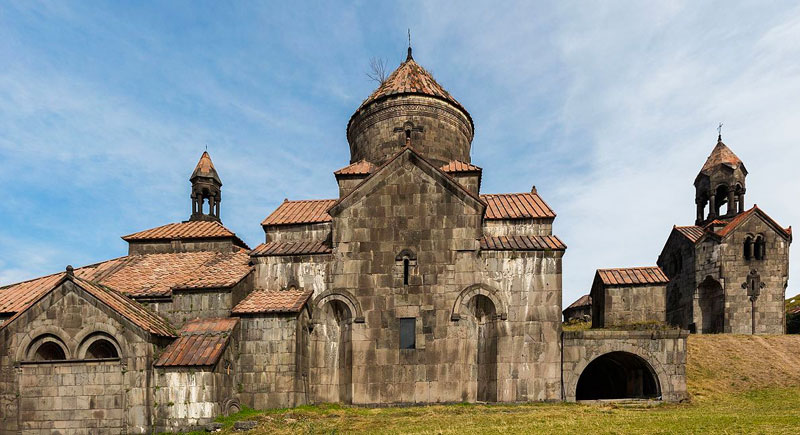
- On 1 Nov 2017
- In Article
Prototype of European churches - Armenian churches
This tour will take you to the distant past of Armenia. You will see the domed basilica of Odzun monastery, the ancient monastery of Haghpat, Sanahin monastery, the monastery complex Goshavank.
19. St. Gregory the Illuminator church in Vanadzor
Saint Gregory the Illuminator church in Vanadzor was built in 2005. In 2007, the altar of the church was decorated with frescoes of Armenian saints and works of art that perpetuate the memory of the saints and the history of the Armenian church. Since 2012, the construction of the chapel-bell tower of St. Gregory Narekatsi began in the church.
Grigor Narekatsi (about 951-1003) was a medieval priest, a Christian theologian, a mystical poet, musician and philosopher. He is considered the founder of the revival of Armenian literature, the Armenian philosopher of the Renaissance.
From the works of Narekatsi the collection "A Book of Mournful Chants" is very popular. In February 2015, the Pontifical Council ranked Grigor Narekatsin as the teacher of the Catholic Church.
20. Odzun Monastery
According to a tradition, the Apostle Thomas in the 1st century BC, by coming to Odzun anointed the priests and bishops in the Church due to which the word Odzun was presumably derived.
The present building of the church has been preserved since the 5th century, but it is believed that it was built in the 4th century by Grigor Illuminator and Trdat III on the site of a church belonging to the same basilica. In the 5th century it was a wooden basilica with tiled facing slabs, and domes and stone arches were added in the VI century. In the 8th century, Ovan Odznetsi replaced the tiled slabs with stones. In 1888, two small bell towers were added by Abovyan family.
21. Haghpat Monastery
Haghpat monastery was founded in the second half of the 10th century. In the 10th and 13th centuries it was one of the most famous spiritual and cultural centers of Armenia. Its’ economic, cultural, and structural growth lasted from the second half of the 12th century up to the end of the 14th century. Its school and library were extremely well-known in the 11th -13th centuries. Philosophy, rhetoric, theology, music and other subjects were taught here, and inscriptions were copied and illustrated (Manuscript repository, school, and gospel of Haghpat). The monastery was repeatedly subjected to invasions and earthquakes. It was a temporary home for the famous poet Sayat-Nova.
22. Sanahin monastery
Sanahin monastery was founded in 966 by the Armenian king Ashot G Voghormats. Sanahin used to be the administrative centre and family burial place of the Kyurikyan Bagratids (10th and 11th centuries), as well as the Episcopal residence for the diocese (until the 11th century).
The University of Sanahin was founded in 966 by Khosrovanush, and was an important educational center in medieval Armenia. In the first half of the 11th century, colleges of rhetoric, philosophy, music, and medicine were opened in the University and offered subjects like seven free arts and Tomar, an ancient Armenian calendar system. Nearby, a manuscript repository was built. However, in 1,998, the manuscript repository was handed to the St. Mother See of Holy Etchmiadzin by the decision of the government of Armenia.
In 2001, the Sanahin complex was included in the UNESCO World Heritage List. One of the best engineering structures of medieval Armenian architecture is the Sanahin Bridge. In the XII century it was built by order of Armenian queen Vaneni. The road leading to the Sanahin monastery passes through the bridge.
23. Goshavank
One of the most famous religious, educational and cultural centers of the 12th-13th centuries is the new monastery complex "Getik" (Goshavank) located in the village of Gosh in the Tavush region on the bank of Getik river
Goshavank was erected in 1188 on the place of ancient monastery Getik destroyed by the earthquake. Built by Mkhitar Gosh it was firstly named Nor Getik (New Getik), while after his death, in 1213, it was named Goshavank, after Mkhitar Gosh
In historical sources it is mentioned as a seminary, university, etc. Here, Armenian and foreign languages (Greek, Latin), grammar, philosophy, rhetoric, music, art of writing, painting were taught. Famous cultural figures were educated here.
Not far from the monastery in the southern part of the village there are the buildings: the small Cathedral of St. Gevorg (1254), the remains of the house of Mkhitar Gosh, his mausoleum.